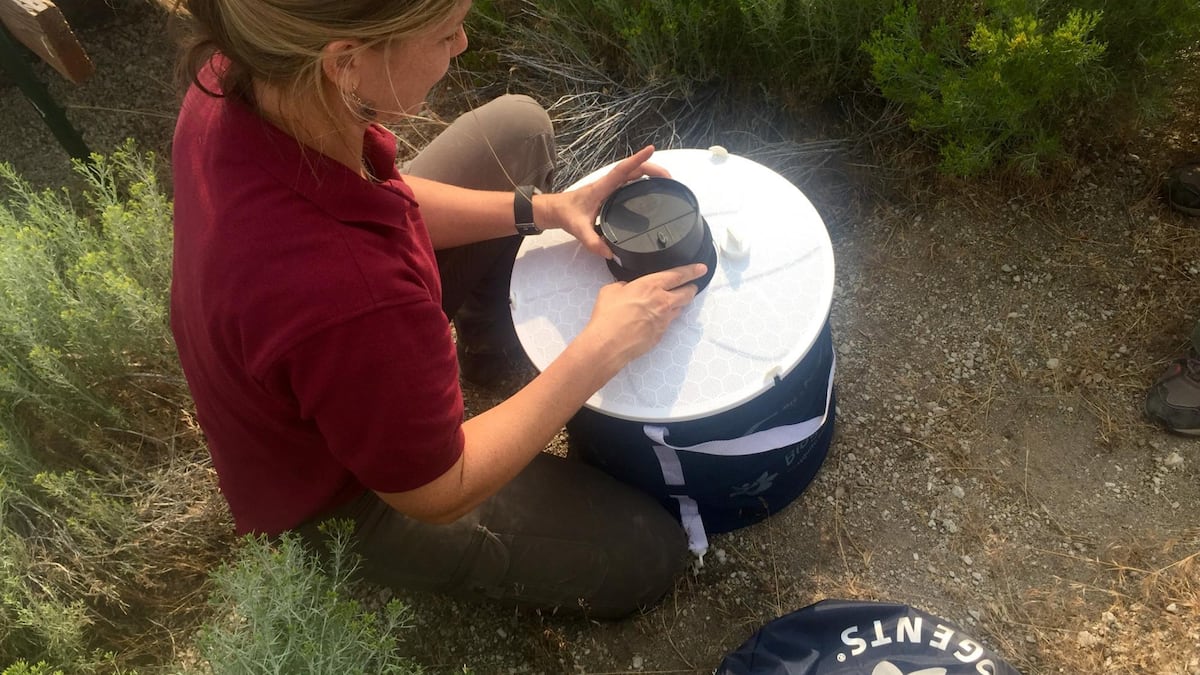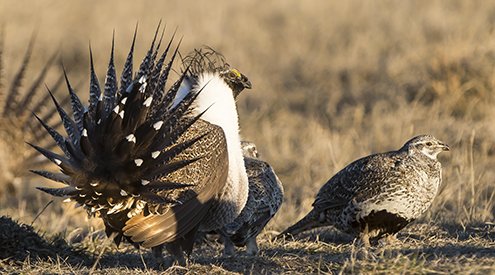IMO personnel moving around is small to non-issue when it comes to implementing policy/projects. Things like monitoring/inventory/data collection it is more of an issue, but still far from large. Leadership and leadership commitment to working on the issue. From DC to field office.No plan is perfect, to be sure.
I wonder is having personnel that move around a lot complicates this all more. If every Federal Land Agency employee has to spend so much time building relationships rather than working on issues, it can't be helpful. I've heard this over and over relative to the FS, but not so sure if it happens in the BLM or NRCS, etc.
Navigation
Install the app
How to install the app on iOS
Follow along with the video below to see how to install our site as a web app on your home screen.
Note: This feature may not be available in some browsers.
More options
You are using an out of date browser. It may not display this or other websites correctly.
You should upgrade or use an alternative browser.
You should upgrade or use an alternative browser.
The Sage Grouse Crisis has Reached Critical Mass
- Thread starter Ben Lamb
- Start date
elkduds
Well-known member
The grouse are the canaries. The sagebrush habitat is the coalmine.
The OP article begins to describe the myriad difficulties and shortcomings of the 2015 Great Compromise. It was a model of cooperative consensus that Trump wiped his a$$ with and flushed. That decision poisoned the well for other Great Compromises. Rebuilding them in the future will be far more complicated, expensive and w less certain outcomes.
The OP article begins to describe the myriad difficulties and shortcomings of the 2015 Great Compromise. It was a model of cooperative consensus that Trump wiped his a$$ with and flushed. That decision poisoned the well for other Great Compromises. Rebuilding them in the future will be far more complicated, expensive and w less certain outcomes.
The grouse are the canaries. The sagebrush habitat is the coalmine.
The OP article begins to describe the myriad difficulties and shortcomings of the 2015 Great Compromise. It was a model of cooperative consensus that Trump wiped his a$$ with and flushed. That decision poisoned the well for other Great Compromises. Rebuilding them in the future will be far more complicated, expensive and w less certain outcomes.
They tried, but due to incompetence on the DOI's part, the plans were reinstated. https://www.audubon.org/news/judge-blocks-trump-administration-plans-lifted-sage-grouse-protections
elkduds
Well-known member
Thanks Ben. That is seriously the most optimistic habitat news I have heard in eons.They tried, but due to incompetence on the DOI's part, the plans were reinstated. https://www.audubon.org/news/judge-blocks-trump-administration-plans-lifted-sage-grouse-protections
kwyeewyk
Well-known member
Of course not, THEY don't publish it because it's a big conspiracy!Can you post some sources
Thanks Ben. That is seriously the most optimistic habitat news I have heard in eons.
Nada Culver, the lawyer for Audubon that is quoted in the article and who was instrumental in pushing back on the previous administrations attempts to undermine this effort, is now the deputy director for the BLM - the spot that William Perry Pendley had.
So we've got that going for us as well.
OntarioHunter
Well-known member
- Joined
- Sep 11, 2020
- Messages
- 5,997
There weren't billions of acres of Great Plains under cultivation back in the free roaming bison days. I am not sure there were more bison on the range back then than there are cattle today but it's obvious the amount of grazing range is a fraction today what it was back then. And no, sage grouse will not nest in grain fields. In fact, I have yet to see one even feeding in a grain field (but they do like alfafa). Also, bison were highly migratory. They weren't fenced in and grazing the same piece of land through most of the year. Consequently there was more cover on the range back then. I can certainly see how the reduction in cover can lead to more egg predation from ravens and crows.For those of you who are grazing experts . . .
How does cattle grazing differ from bison grazing? I've read stories of the millions of bison and the millions of sage grouse which used to inhabit the intermountain west simultaneously. I'm not a grazing expert, but I'm not sure I understand how millions of bison weren't more destructive to sage grouse nests and nesting conditions than a few hundred thousand head of cattle.
Hydrophilic
Well-known member
Of course not, THEY don't publish it because it's a big conspiracy!
It does appear to be an issue.
I did not, however, find a resource recommending we should therefore stop addressing habitat conversion, energy development, conifer intrusion, climate change, and cheatgrass...in favor of a sage grouse strategy that focuses soley on WNV and predators. Maybe 88man has more info.

West Nile virus and greater sage-grouse: estimating infection rate in a wild bird population - PubMed
Understanding impacts of disease on wild bird populations requires knowing not only mortality rate following infection, but also the proportion of the population that is infected. Greater sage-grouse (Centrocercus urophasianus) in western North America are known to have a high mortality rate...

Learning About West Nile To Save Sage Grouse
Mosquitoes can carry dangerous diseases — like the West Nile virus. Turns out, the mosquito-transmitted virus is deadly for one of the West’s most iconic birds: the sage grouse.
www.opb.org
I will agree that sage grouse are not good eating but I personally think they are beautiful birds, especially the males.It won't bother me if they close the season on sage grouse. They taste like crap and don't make an attractive mount so what's the point in shooting them? Right now it's all about filling some grand slam on uplands before the species is listed. Shooting for the sake of shooting. Lots of other edible birds in Montana to hunt and such a variety I can switch from species to species year to year depending on how they're doing. For example, I haven't shot a Hun for several years. Just not finding enough of them. I held off on sharpies for a while but took quite a few last year. They were everywhere! Pheasants are different because roosters can be identified. They can be hunted even in lean years without affecting conservation very much.
I haven't shot one in probably 20 years, though I do see them occasionally.
Perhaps it is time to close the season on them everywhere for a few years and see if it helps along with doing what's possible to help the habitat as well.

kwyeewyk
Well-known member
Yep certainly an issue, but absolutely not the primary cause. I work with one of the leading grouse experts in the world here in Washington, this guy lives and breathes grouse, all kinds of grouse, a true love for them, and if WNV were anywhere near the threat implied by 88 I'd have heard about it. The science is real, and the primary threats are well documented. Grazing, by the way, is not considered a primary threat.It does appear to be an issue.
I did not, however, find a resource recommending we should therefore stop addressing habitat conversion, energy development, conifer intrusion, climate change, and cheatgrass...in favor of a sage grouse strategy that focuses soley on WNV and predators. Maybe 88man has more info.

West Nile virus and greater sage-grouse: estimating infection rate in a wild bird population - PubMed
Understanding impacts of disease on wild bird populations requires knowing not only mortality rate following infection, but also the proportion of the population that is infected. Greater sage-grouse (Centrocercus urophasianus) in western North America are known to have a high mortality rate...pubmed.ncbi.nlm.nih.gov

Learning About West Nile To Save Sage Grouse
Mosquitoes can carry dangerous diseases — like the West Nile virus. Turns out, the mosquito-transmitted virus is deadly for one of the West’s most iconic birds: the sage grouse.www.opb.org
OntarioHunter
Well-known member
- Joined
- Sep 11, 2020
- Messages
- 5,997
Yes, the males are spectacular during the brief period of courtship. But during hunting season they are blah to look at. I haven't shot one in forty years. No regrets.I will agree that sage grouse are not good eating but I personally think they are beautiful birds, especially the males.
I haven't shot one in probably 20 years, though I do see them occasionally.
Perhaps it is time to close the season on them everywhere for a few years and see if it helps along with doing what's possible to help the habitat as well.
View attachment 182430
thebestusernamesaretaken
Well-known member
- Joined
- Feb 19, 2021
- Messages
- 476
I happened to run across this from WSF https://www.wildsheepfoundation.org/mission-and-programs/conservation-programs/cheatgrass that may apply
WNV was a seriously large issue when all of the CBM wastewater wells were dotting the landscape, and it's still around in serious enough numbers to warrant concern, but you simply can't focus on treating WNV over treating habitat to create enough space for the GSG to thrive. Predation losses are exacerbated when habitat loses functionality, and when human disturbance of soils increases.
I was part of a study in WY in the late 2000's that put game cameras out on grouse nests to see what was eating eggs - turns out it's everything. Even elk & deer raid nests for eggs from time to time. Corvids & racoons were the largest offenders, followed by skunks, iirc.
I was part of a study in WY in the late 2000's that put game cameras out on grouse nests to see what was eating eggs - turns out it's everything. Even elk & deer raid nests for eggs from time to time. Corvids & racoons were the largest offenders, followed by skunks, iirc.
Its complex like god made it be. Of course we should address and understand all the factors affecting the decline. However, why would you not want to make the primary focus on west nile since most people don't know about it please put light to it and it has caused population crashes in various local areas multiple years since 1999. It has to be considered a Major player in the decline in many areas and it just doesn't get the press, why???? You know why. Ah once They accept it then it will get filed under climate change so it meets the agenda. It has also basically wiped the ruffed grouse out in eastern pa. Researchers have found that various areas of New York State Ruffed Grouse have natural genetic immunity to WSN. Maybe we can hope>>>It does appear to be an issue.
I did not, however, find a resource recommending we should therefore stop addressing habitat conversion, energy development, conifer intrusion, climate change, and cheatgrass...in favor of a sage grouse strategy that focuses soley on WNV and predators. Maybe 88man has more info.

West Nile virus and greater sage-grouse: estimating infection rate in a wild bird population - PubMed
Understanding impacts of disease on wild bird populations requires knowing not only mortality rate following infection, but also the proportion of the population that is infected. Greater sage-grouse (Centrocercus urophasianus) in western North America are known to have a high mortality rate...pubmed.ncbi.nlm.nih.gov

Learning About West Nile To Save Sage Grouse
Mosquitoes can carry dangerous diseases — like the West Nile virus. Turns out, the mosquito-transmitted virus is deadly for one of the West’s most iconic birds: the sage grouse.www.opb.org
At some point in the near future a plan to treat stock tanks and standing water will need to be implemented or the sage grouse will be just about gone. We do enjoy the greater numbers of elk/deer/antelope in the non traditional desert areas with man made water or areas that would have limited elk/deer/antelope populations due to lack of water.
Ok we can talk about wind energy and the sage grouse>> share your thoughts
To anyone interested. Not wanting to debate, just passing along some info. Eight year old report.Yep certainly an issue, but absolutely not the primary cause. I work with one of the leading grouse experts in the world here in Washington, this guy lives and breathes grouse, all kinds of grouse, a true love for them, and if WNV were anywhere near the threat implied by 88 I'd have heard about it. The science is real, and the primary threats are well documented. Grazing, by the way, is not considered a primary threat.
Threats table starts on pg 16
There is some West Nile info in the COT Report as well.
Hawk Tuah
Well-known member
- Joined
- Apr 6, 2018
- Messages
- 1,796
I think the idea is logical, but I was corrected on this by a friend of mine who I run a bird dog training kennel with. He was the USFS biologist point person on all things sage grouse when they were being considered for being listed under ESA. He lived and breathed it and is still heavily involved with them. I did some lek counts with him which were neat.I will agree that sage grouse are not good eating but I personally think they are beautiful birds, especially the males.
I haven't shot one in probably 20 years, though I do see them occasionally.
Perhaps it is time to close the season on them everywhere for a few years and see if it helps along with doing what's possible to help the habitat as well.
View attachment 182430
He told me that hunter kill with current regulations was a compensatory source of mortality and has little to no effect. If the local habitat's carrying capacity can sustain 100 birds and there are 130...30 will die before the next round of chicks...regardless of whether they get shot by hunters, eaten by coyotes, etc. Carrying capacity is the issue, not hunter harvest.
It is interesting to hear him speak about grouse. He summed it up well to me... He said it is a difficult situation because habitat fragmentation and loss due to fire are the biggest threat. But the birds also need some of the ground cover that gets eaten by cattle when they graze in sagebrush habitat...that understory around the sage....but the grazing is what prevents the hot and fast moving fires. So they need some grazed and some stuff left alone. It is a circular issue.
Personally, I think ESA is broken and too politicized and needs to be scrapped and replaced.
Any ideas?Personally, I think ESA is broken and too politicized and needs to be scrapped and replaced.
OntarioHunter
Well-known member
- Joined
- Sep 11, 2020
- Messages
- 5,997
I have yet to see a sage grouse flying high enough to get whacked by a wind turbine. Maybe the crows, ravens, and hawks that eat them and their eggs.Ok we can talk about wind energy and the sage grouse>> share your thoughts
Handlebar
Well-known member
- Joined
- Jul 15, 2014
- Messages
- 329
I have often wondered how cyclical their populations are. We have a biological survey that was done in 1911 for the
General Biological Services. Speaking about the GSG the author state that within a few years the only GSG in the area would be a lone refugee from Montana. during one of the season in the fifties the SDGFP collected 15,000 wings in wing barrels.
General Biological Services. Speaking about the GSG the author state that within a few years the only GSG in the area would be a lone refugee from Montana. during one of the season in the fifties the SDGFP collected 15,000 wings in wing barrels.
kwyeewyk
Well-known member
That's because they tend to avoid them, they don't like tall objects overhead, but that doesn't mean they aren't affected by them, = habitat fragmentation.I have yet to see a sage grouse flying high enough to get whacked by a wind turbine. Maybe the crows, ravens, and hawks that eat them and their eggs.
WNV associated wastewater wells, settling ponds, etc a side effect of habitat fragmentation.
Increased predator activity such as ravens/coyotes is supported by habitat fragmentation and human food subsidies (feed lots, dumps, road kill etc=habitat for predators).
It all comes back to habitat, as hunters we should all know that.
Similar threads
- Replies
- 108
- Views
- 9K
- Replies
- 199
- Views
- 12K




